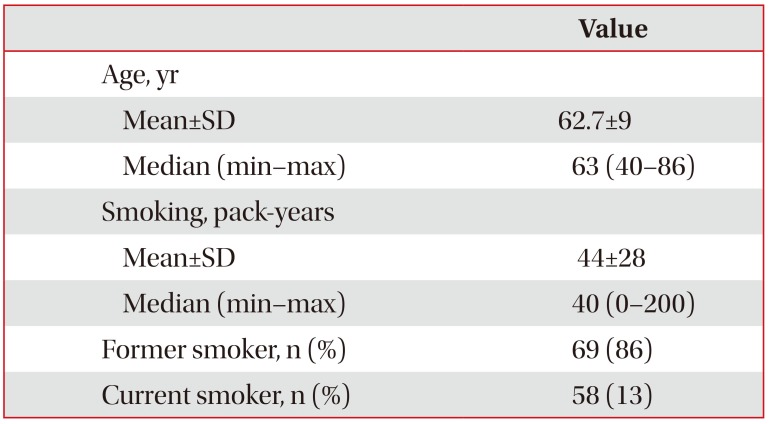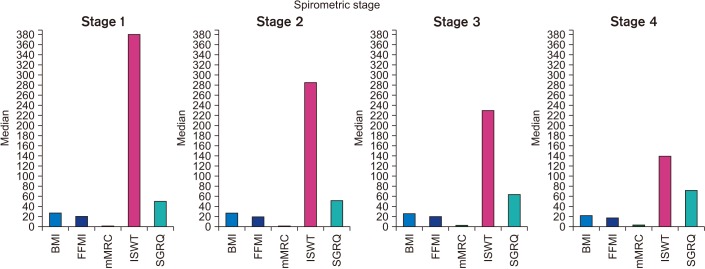1. Global Initiative for Chronic Obstructive Lung Disease. Global strategy for the diagnosis, management and prevention of chronic, obstructive pulmonary disease, 2017 report [Internet]. Global Initiative for Chronic Obstructive Lung Disease;2017. cited 2017 Dec 5. Available from:
http://goldcopd.org.
2. Rennard SI, Vestbo J. COPD: the dangerous underestimate of 15%. Lancet. 2006; 367:1216–1219. PMID:
16631861.

3. Soriano JB, Lamprecht B, Ramirez AS, Martinez-Camblor P, Kaiser B, Alfageme I, et al. Mortality prediction in chronic obstructive pulmonary disease comparing the GOLD 2007 and 2011 staging systems: a pooled analysis of individual patient data. Lancet Respir Med. 2015; 3:443–450. PMID:
25995071.

4. Goossens LM, Leimer I, Metzdorf N, Becker K, Rutten-van Molken MP. Does the 2013 GOLD classification improve the ability to predict lung function decline, exacerbations and mortality: a
post-hoc analysis of the 4-year UPLIFT trial. BMC Pulm Med. 2014; 14:163. PMID:
25326750.

5. Kim J, Yoon HI, Oh YM, Lim SY, Lee JH, Kim TH, et al. Lung function decline rates according to GOLD group in patients with chronic obstructive pulmonary disease. Int J Chron Obstruct Pulmon Dis. 2015; 10:1819–1827. PMID:
26379432.

6. Han MK, Muellerova H, Curran-Everett D, Dransfield MT, Washko GR, Regan EA, et al. GOLD 2011 disease severity classification in COPDGene: a prospective cohort study. Lancet Respir Med. 2013; 1:43–50. PMID:
24321803.

7. Fletcher CM. Standardised questionnaire on respiratory symptoms. Br Med J. 1960; 2:1665. PMID:
13688719.
8. Singh SJ, Morgan MD, Scott S, Walters D, Hardman AE. Development of a shuttle walking test of disability in patients with chronic airways obstruction. Thorax. 1992; 47:1019–1024. PMID:
1494764.

9. Aydemir O, Guvenir T, Kuey L, Kultur S. Validity and reliability of Turkish version of Hospital Anxiety and Depression Scale. Turk Psikiyatri Derg. 1997; 8:280–287.
10. Jones PW, Quirk FH, Baveystock CM, Littlejohns P. A selfcomplete measure of health status for chronic airflow limitation. The St. George's Respiratory Questionnaire. Am Rev Respir Dis. 1992; 145:1321–1327. PMID:
1595997.

11. Polatli M, Yorgancioglu A, Aydemir O, Yilmaz Demirci N, Kırkil G, Atis Nayci S, et al. St. George Solunum Anketinin Turkce gecerlilik ve guven ilirligi. Tuberkuloz Toraks. 2013; 61:81–87.
12. Hurst JR, Vestbo J, Anzueto A, Locantore N, Mullerova H, Tal-Singer R, et al. Susceptibility to exacerbation in chronic obstructive pulmonary disease. N Engl J Med. 2010; 363:1128–1138. PMID:
20843247.

13. Anzueto A, Leimer I, Kesten S. Impact of frequency of COPD exacerbations on pulmonary function, health status and clinical outcomes. Int J Chron Obstruct Pulmon Dis. 2009; 4:245–251. PMID:
19657398.
14. Kanner RE, Anthonisen NR, Connett JE. Lung Health Study Research Group. Lower respiratory illnesses promote FEV(1) decline in current smokers but not ex-smokers with mild chronic obstructive pulmonary disease: results from the lung health study. Am J Respir Crit Care Med. 2001; 164:358–364. PMID:
11500333.
15. Cote CG, Dordelly LJ, Celli BR. Impact of COPD exacerbations on patient-centered outcomes. Chest. 2007; 131:696–704. PMID:
17356082.

16. Vestbo J, Edwards LD, Scanlon PD, Yates JC, Agusti A, Bakke P, et al. Changes in forced expiratory volume in 1 second over time in COPD. N Engl J Med. 2011; 365:1184–1192. PMID:
21991892.

17. Agusti A, Calverley PM, Celli B, Coxson HO, Edwards LD, Lomas DA, et al. Characterisation of COPD heterogeneity in the ECLIPSE cohort. Respir Res. 2010; 11:122. PMID:
20831787.

18. Seemungal TA, Donaldson GC, Paul EA, Bestall JC, Jeffries DJ, Wedzicha JA. Effect of exacerbation on quality of life in patients with chronic obstructive pulmonary disease. Am J Respir Crit Care Med. 1998; 157(5 Pt 1):1418–1422. PMID:
9603117.

19. Connors AF Jr, Dawson NV, Thomas C, Harrell FE Jr, Desbiens N, Fulkerson WJ. Outcomes following acute exacerbation of severe chronic obstructive lung disease. The SUPPORT investigators (Study to Understand Prognoses and Preferences for Outcomes and Risks of Treatments). Am J Respir Crit Care Med. 1996; 154(4 Pt 1):959–967. PMID:
8887592.

20. Gunen H, Hacievliyagil SS, Kosar F, Mutlu LC, Gulbas G, Pehlivan E, et al. Factors affecting survival of hospitalised patients with COPD. Eur Respir J. 2005; 26:234–241. PMID:
16055870.

21. Soler-Cataluna JJ, Martinez-Garcia MA, Roman Sanchez P, Salcedo E, Navarro M, Ochando R. Severe acute exacerbations and mortality in patients with chronic obstructive pulmonary disease. Thorax. 2005; 60:925–931. PMID:
16055622.

22. Hallin R, Koivisto-Hursti UK, Lindberg E, Janson C. Nutritional status, dietary energy intake and the risk of exacerbations in patients with chronic obstructive pulmonary disease (COPD). Respir Med. 2006; 100:561–567. PMID:
16019198.

23. Zapatero A, Barba R, Ruiz J, Losa JE, Plaza S, Canora J, et al. Malnutrition and obesity: influence in mortality and readmissions in chronic obstructive pulmonary disease patients. J Hum Nutr Diet. 2013; 26(Suppl 1):16–22. PMID:
23656492.

24. Donaldson GC, Wilkinson TM, Hurst JR, Perera WR, Wedzicha JA. Exacerbations and time spent outdoors in chronic obstructive pulmonary disease. Am J Respir Crit Care Med. 2005; 171:446–452. PMID:
15579723.

25. Bagade AA, Jiandani MP, Mehta A. Medical research council dyspnoea score and forced expiratory volume in one second as the predictors of vertical climbing in chronic obstructive pulmonary disease patients. Int J Res Med Sci. 2017; 5:1558–1562.

26. Bestall JC, Paul EA, Garrod R, Garnham R, Jones PW, Wedzicha JA. Usefulness of the Medical Research Council (MRC) dyspnoea scale as a measure of disability in patients with chronic obstructive pulmonary disease. Thorax. 1999; 54:581–586. PMID:
10377201.

27. Kaymaz D, Candemir IC, Ergun P, Demir N, Tasdemir F, Demir P. Relation between upper-limb muscle strength with exercise capacity, quality of life and dyspnea in patients with severe chronic obstructive pulmonary disease. Clin Respir J. 2018; 12:1257–1263. PMID:
28618190.

28. Stenton C. The MRC breathlessness scale. Occup Med (Lond). 2008; 58:226–227. PMID:
18441368.

29. Divo M, Cote C, de Torres JP, Casanova C, Marin JM, Pinto-Plata V, et al. Comorbidities and risk of mortality in patients with chronic obstructive pulmonary disease. Am J Respir Crit Care Med. 2012; 186:155–161. PMID:
22561964.

30. Abusaid GH, Barbagelata A, Tuero E, Mahmood A, Sharma G. Diastolic dysfunction and COPD exacerbation. Postgrad Med. 2009; 121:76–81. PMID:
19641273.

31. Exuzides A, Colby C, Briggs AH, Lomas DA, Rutten-van Molken MP, Tabberer M, et al. Statistical modeling of disease progression for chronic obstructive pulmonary disease using data from the ECLIPSE study. Med Decis Making. 2017; 37:453–468. PMID:
26449490.








 PDF
PDF ePub
ePub Citation
Citation Print
Print





 XML Download
XML Download